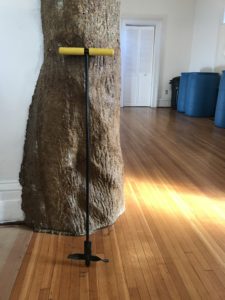When putting foods into your compost bin try to maintain a mixture of 50% greens and 50% browns (by weight, not by volume). Since browns tend to be lighter, you will typically need to add 2 to 3 pails of browns for every 1 pail of greens.
Feed yard trimmings to your bin as you generate them by chopping them first into pieces 6” or smaller. A general rule to follow is that “smaller is better” when if comes to the size of your compost food. If you have time to cut, chop, or shred your organic waste before putting it into your compost bin, you will see faster decomposition rates.
Food scraps and grass clippings need to be buried or mixed into the center of the pile (never “dump and run” or else you will have animals and flies attracted to the smells in your bin.) Covering your “greens” with a generous layer of “browns” helps prevent odors and unwanted pests. You can also add soil at any stage of the layering process. A shovel-full of soil will introduce many soil organisms into your pile and acts as an accelerator. A thin layer of soil added on the top of your pile also helps to discourage pests and odors.
The microorganisms in your pile need water to survive, but not too much or they will not be able to “breathe”. Ideally, you want your compost to have a moisture content of 50% or so. If you squeeze a handful it should leave your hand moist but not drip more than a few drops. Use a rain barrel, watering can, or hose to keep the compost pile as moist as wrung-out sponge. Remember when you add greens, you are also adding water since greens have a high moisture content.

Air may only reach the top and sides of the compost pile but to keep the microorganisms in your compost bin healthy, oxygen must get into the bottom and center as well. To increase decomposition, aerate your compost pile about every 2 to 3 weeks, or anytime you add material; either by using a shovel, pitchfork, rake, or a compost aerating tool. This could involve mixing the whole pile or simply poking holes to make air channels throughout your heap. If you don’t aerate your pile, there is also a risk that your pile may begin to compost anaerobically (without oxygen), producing an unpleasant smell and methane gas. Turning your pile too often may slow down decomposition since your pile won’t have the time to heat up and could dry out.
If you are building your own compost bin, you should keep in mind that the ideal volume for your bin is about 1 meter cubed. A bin that is too small cannot retain enough heat and a bin that is too large won’t allow enough air to reach the center of your compost pile. It is also easier to manage two or three medium bins than one large one.
Achieving finished compost can take a few months to 3 years depending on how much effort you put into it. Finished compost is found at the bottom or center of the bin. It is ready to use as a natural fertilizer when it is dark brown, smells like earth and crumbles in your hand. If it still has a lot of large lumps or is still warm, let it sit for another couple weeks.
